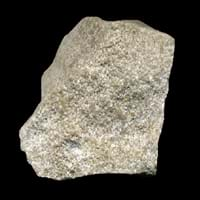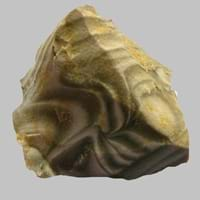Definition
Oolite is a sedimentary rock formed from ooids, spherical grains which are composed of concentric layers of calcite
Flint is a hard type of sedimentary rock that produces a small piece of burning material when hit by steel
Discoverer
Unknown
Unknown
Etymology
From oo- + -lite, after German Oolit. A rock consisting of fine grains of carbonate of lime
From Old English flint - a type of rock mainly known for high hardness and for giving off sparks when struck
Class
Sedimentary Rocks
Sedimentary Rocks
Sub-Class
Durable Rock, Medium Hardness Rock
Durable Rock, Hard Rock
Group
Volcanic
Not Applicable
Other Categories
Fine Grained Rock, Opaque Rock
Fine Grained Rock, Opaque Rock
Texture
Clastic or Non-Clastic
Banded, Rough
Color
Black, Blue, Brown, Cream, Green, Grey, Pink, Red, Silver, White, Yellow
Black, Brown, Green, Grey, Red, White
Durability
Durable
Durable
Scratch Resistant
Yes
Yes
Appearance
Rounded and Rough
Glassy or Pearly
Interior Uses
Decorative Aggregates, Flooring, Interior Decoration
Decorative Aggregates, Homes, Interior Decoration
Exterior Uses
As Building Stone, As Facing Stone, Garden Decoration, Paving Stone
As Building Stone, As Facing Stone, Garden Decoration, Office Buildings, Paving Stone
Other Architectural Uses
Not Yet Used
Curbing
Construction Industry
Cement Manufacture, Cobblestones, Landscaping
Arrowheads, Cutting Tool, Spear Points
Medical Industry
Not Yet Used
Not Yet Used
Antiquity Uses
Artifacts
Artifacts
Commercial Uses
Creating Artwork, Jewelry, Used in aquariums
Creating Artwork, Gemstone, In fire-starting tools, Manufacture of tools, Metallurgical Flux, Jewelry, To ignite fire, Used in flintlock firearms
Types
Not Available
Not Available
Features
Available in lots of colors, Generally rough to touch, Very fine grained rock
Clasts are smooth to touch, Easily splits into thin plates, Has High structural resistance against erosion and climate
Archaeological Significance
Monuments
Not Yet Used
Not Yet Used
Famous Monuments
Not Applicable
Not Applicable
Sculpture
Not Yet Used
Not Yet Used
Famous Sculptures
Not Applicable
Not Applicable
Pictographs
Used
Not Used
Petroglyphs
Used
Not Used
Figurines
Not Yet Used
Not Yet Used
Formation
Oolites form when layers of calcite are deposited around a sand grain or fossil piece and are rolled around in calm water, which makes them round.
Flint is formed by the decomposition and compaction of various organisms such as sponges and diatoms under the water.
Mineral Content
Calcite, Chert, Clay, Dolomite, Quartz, Sand, Silt
Silicon
Compound Content
Aluminium Oxide, Ca, NaCl, CaO, Iron(III) Oxide, FeO, MgO
Silicon Dioxide
Types of Metamorphism
Not Applicable
Not Applicable
Types of Weathering
Biological Weathering, Chemical Weathering, Mechanical Weathering
Not Applicable
Types of Erosion
Chemical Erosion, Coastal Erosion
Chemical Erosion, Coastal Erosion, Water Erosion
Grain Size
Fine Grained
Very fine-grained
Fracture
Conchoidal
Conchoidal
Porosity
Less Porous
Highly Porous
Luster
Pearly to Shiny
Vitreous
Compressive Strength
Not Available
Cleavage
Non-Existent
Non-Existent
Specific Gravity
Not Available
2.5-2.8
Transparency
Opaque
Translucent to Opaque
Density
Not Available
2.7-2.71 g/cm3
Specific Heat Capacity
Not Available
Resistance
Heat Resistant, Wear Resistant
Heat Resistant, Impact Resistant, Pressure Resistant, Wear Resistant
Deposits in Eastern Continents
Asia
Brunei, India, Indonesia, Malaysia, Singapore, Thailand, Vietnam
Azerbaijan, China, Russia
Africa
Cameroon, Chad, Ghana, Kenya, Malawi, Sudan, Tanzania, Togo, Zambia, Zimbabwe
Not Yet Found
Europe
United Kingdom
Austria, Belgium, Cyprus, Denmark, France, Germany, Italy, Malta, Netherlands, Poland, Portugal, Romania, Spain, Sweden, Switzerland, Turkey, Ukraine, United Kingdom
Others
Not Yet Found
Not Yet Found
Deposits in Western Continents
South America
Colombia
Bolivia
Deposits in Oceania Continent
Australia
Adelaide, New Zealand, Queensland, Tonga, Victoria, Yorke Peninsula
New Zealand, South Australia
All about Oolite and Flint Properties
Know all about Oolite and Flint properties here. All properties of rocks are important as they define the type of rock and its application. Oolite and Flint belong to Sedimentary Rocks.Texture of Oolite is Clastic or Non-Clastic whereas that of Flint is Banded, Rough. Oolite appears Rounded and Rough and Flint appears Glassy or Pearly. The luster of Oolite is pearly to shiny while that of Flint is vitreous. Oolite and Flint are available in black, blue, brown, cream, green, grey, pink, red, silver, white, yellow colors. The commercial uses of Oolite are creating artwork, jewelry, used in aquariums and that of Flint are creating artwork, gemstone, in fire-starting tools, manufacture of tools, metallurgical flux, jewelry, to ignite fire, used in flintlock firearms.










